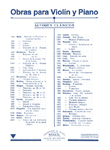WORKS
- Genre
-
Musical education
- Choir
- Counterpoint
- Dictation
- Direction
- Exam study manuals
- General music pedagogy
- Harmony
- Hearing
- Illustrations / Posters
- Improvisation / Sight reading
- Instrument methods
- Instrument pedagogy
- Instrumental study repertoire
- Instrumentation and orquestration
- Musical language
- Solfège
- Templates
- Theory and analysis
-
Incidental music
-
Lined paper
-
Flamenco
-
Religious music
-
Classical / contemporary
-
Modern music
-
Folk music / traditional
-
Musicology
-
Divulgation
-
Games and hobbies
-
Music therapy
-
Children / Youth
-
- Instruments
- Ensemble
- Difficulty level
- Period
- Genre
SOPORTE
Search
Find here: books, scores, composers, digital pieces, cd's
Best-selling works
Our classics
Newsletter
I wish to be informed of the news about your music
We have received your e-mail correctly
Multimedia
La serra
Materiales de orquesta sinfónica en alquiler
Voces solistas, Coro mixto y Orquesta sinfónica
OLTRA, ManuelOLTRA, ManuelOLTRA, ManuelReg.: B.3572o
- Ensemble: Symphonic orchestra: With voice/choir.
- Genres: Classical / contemporary: Choir; Symphonic.
- Lyric author: ALCOVER, Joan
- Language: Catalán
- Product format: Partitura + particellas
- Difficulty level: Advanced-superior
- Period: 2nd half S. XX - XXI
- Publishing house: Editorial Boileau
- Collection: Siglo XXI
- No. of pages: 100
- Measure: 29,70 x 21,00 cm
- Lenght: 21'
- ISMN: 979-0-3503-0764-5
- Available in digital: No
- Available for rent: Yes
Solo: Ms, Bar
Mixed choir
2 2 2 2 — 2 1 0 0 — tmp — hp — str
Strings: 7,6,5,4,3
La Serra - Poem for soloists, chorus and orchestra by Manel Oltra based on a poem of the same name by the Mallorcan poet Joan Alcover (1854-1926) and dedicated to Oltra’s friend and colleague Miquel Costa i Llobera. The bucolic text deals with rural life in the mountains of Tramuntana on the island of Mallorca.
The score consists of two parts which were composed at different eras, the first in 1958 and the second in 1999. In spite of the space of 41 years that separates both parts, the work maintains a formal unity and expressive language which is always pastoral and uses modal harmonies. This musical language is characteristic of the composer who always seeks out sonorities that evoke traditional folklore.
This work is also published in a version with a piano reduction of the orchestra which is appropriate for rehearsals with soloists and chorus.









